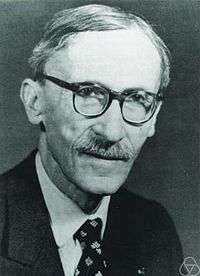Paul Lévy (mathematician)
| Paul Lévy | |
|---|---|
|
Paul Pierre Lévy | |
| Born |
15 September 1886 Paris, France |
| Died |
15 December 1971 (aged 85) Paris, France |
| Nationality | French |
| Fields | Mathematics |
| Institutions |
École Polytechnique École des Mines |
| Alma mater | University of Paris |
| Doctoral advisor |
Jacques Hadamard Vito Volterra |
| Doctoral students |
Wolfgang Doeblin Michel Loève Benoît Mandelbrot Georges Matheron |
| Known for |
Lévy process Lévy flight Lévy measure Lévy's constant Lévy distribution Lévy C curve |
Paul Pierre Lévy (15 September 1886 – 15 December 1971)[1] was a French mathematician who was active especially in probability theory, introducing martingale and Lévy flight. Lévy processes, Lévy measures, Lévy's constant, the Lévy distribution, the Lévy skew alpha-stable distribution, the Lévy area, the Lévy arcsine law, and the fractal Lévy C curve are also named after him.
Biography
Lévy was born in Paris, the son of Lucien Lévy, an examiner at the École Polytechnique. Lévy also attended the École Polytechnique and published his first paper in 1905, at the age of nineteen, while still an undergraduate. His teacher and advisor was Jacques Hadamard. After graduation, he spent a year in military service and then studied for three years at the École des Mines, where he became a professor in 1913.[1]
During World War I Lévy conducted mathematical analysis work for the French Artillery. In 1920 he was appointed Professor of Analysis at the École Polytechnique, where his students included Benoît Mandelbrot and Georges Matheron. He remained at the École Polytechnique until his retirement in 1959, with a gap during World War II after his 1940 firing because of the Vichy Statute on Jews.[1]
Lévy received a number of honours, including membership at the French Academy of Sciences and honorary membership at the London Mathematical Society.[1]
His daughter Marie-Hélène Schwartz and son-in-law Laurent Schwartz were also notable mathematicians.[2]
Works
- 1922 – Lecons d'analyse Fonctionnelle
- 1925 – Calcul des probabilités
- 1937 – Théorie de l'addition des variables aléatoires
- 1948 – Processus stochastiques et mouvement brownien
- 1954 – Le mouvement brownien
See also
- Lévy metric
- Lévy's modulus of continuity
- Lévy–Prokhorov metric
- Lévy's continuity theorem
- Lévy's zero-one law
- Concentration of measure
References
- 1 2 3 4 O'Connor, John J.; Robertson, Edmund F., "Paul Lévy (mathematician)", MacTutor History of Mathematics archive, University of St Andrews.
- ↑ Kosmann-Schwarzbach, Yvette (2015), "Women mathematicians in France in the mid-twentieth century", BSHM Bulletin: Journal of the British Society for the History of Mathematics, arXiv:1502.07597
 , doi:10.1080/17498430.2014.976804.
, doi:10.1080/17498430.2014.976804.
External links
- Rama Cont: Paul Lévy: a biography
- Gérard P. Michon: Paul Lévy and Functional Analysis
- Paul Lévy at the Mathematics Genealogy Project
- O'Connor, John J.; Robertson, Edmund F., "Paul Lévy (mathematician)", MacTutor History of Mathematics archive, University of St Andrews.
